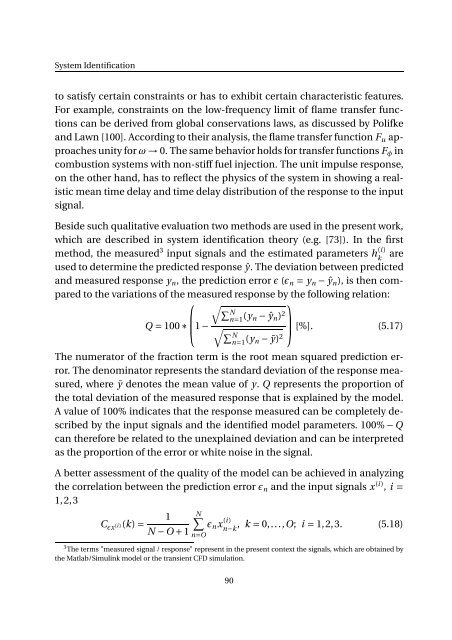Impact of fuel supply impedance and fuel staging on gas turbine ...
Impact of fuel supply impedance and fuel staging on gas turbine ...
Impact of fuel supply impedance and fuel staging on gas turbine ...
Create successful ePaper yourself
Turn your PDF publications into a flip-book with our unique Google optimized e-Paper software.
System Identificati<strong>on</strong><br />
to satisfy certain c<strong>on</strong>straints or has to exhibit certain characteristic features.<br />
For example, c<strong>on</strong>straints <strong>on</strong> the low-frequency limit <str<strong>on</strong>g>of</str<strong>on</strong>g> flame transfer functi<strong>on</strong>s<br />
can be derived from global c<strong>on</strong>servati<strong>on</strong>s laws, as discussed by Polifke<br />
<str<strong>on</strong>g>and</str<strong>on</strong>g> Lawn [100]. According to their analysis, the flame transfer functi<strong>on</strong> F u approaches<br />
unity for ω→0. The same behavior holds for transfer functi<strong>on</strong>s F φ in<br />
combusti<strong>on</strong> systems with n<strong>on</strong>-stiff <str<strong>on</strong>g>fuel</str<strong>on</strong>g> injecti<strong>on</strong>. The unit impulse resp<strong>on</strong>se,<br />
<strong>on</strong> the other h<str<strong>on</strong>g>and</str<strong>on</strong>g>, has to reflect the physics <str<strong>on</strong>g>of</str<strong>on</strong>g> the system in showing a realistic<br />
mean time delay <str<strong>on</strong>g>and</str<strong>on</strong>g> time delay distributi<strong>on</strong> <str<strong>on</strong>g>of</str<strong>on</strong>g> the resp<strong>on</strong>se to the input<br />
signal.<br />
Beside such qualitative evaluati<strong>on</strong> two methods are used in the present work,<br />
which are described in system identificati<strong>on</strong> theory (e.g. [73]). In the first<br />
method, the measured 3 input signals <str<strong>on</strong>g>and</str<strong>on</strong>g> the estimated parameters h (i ) are<br />
k<br />
used to determine the predicted resp<strong>on</strong>se ŷ. The deviati<strong>on</strong> between predicted<br />
<str<strong>on</strong>g>and</str<strong>on</strong>g> measured resp<strong>on</strong>se y n , the predicti<strong>on</strong> error ǫ (ǫ n = y n − ŷ n ), is then compared<br />
to the variati<strong>on</strong>s <str<strong>on</strong>g>of</str<strong>on</strong>g> the measured resp<strong>on</strong>se by the following relati<strong>on</strong>:<br />
⎛ √ ⎞<br />
∑N<br />
⎜<br />
n=1 (y n− ŷ n ) 2<br />
⎟<br />
Q = 100∗⎝1−<br />
√ ∑N<br />
⎠ [%]. (5.17)<br />
n=1 (y n− ȳ) 2<br />
The numerator <str<strong>on</strong>g>of</str<strong>on</strong>g> the fracti<strong>on</strong> term is the root mean squared predicti<strong>on</strong> error.<br />
The denominator represents the st<str<strong>on</strong>g>and</str<strong>on</strong>g>ard deviati<strong>on</strong> <str<strong>on</strong>g>of</str<strong>on</strong>g> the resp<strong>on</strong>se measured,<br />
where ȳ denotes the mean value <str<strong>on</strong>g>of</str<strong>on</strong>g> y. Q represents the proporti<strong>on</strong> <str<strong>on</strong>g>of</str<strong>on</strong>g><br />
the total deviati<strong>on</strong> <str<strong>on</strong>g>of</str<strong>on</strong>g> the measured resp<strong>on</strong>se that is explained by the model.<br />
A value <str<strong>on</strong>g>of</str<strong>on</strong>g> 100% indicates that the resp<strong>on</strong>se measured can be completely described<br />
by the input signals <str<strong>on</strong>g>and</str<strong>on</strong>g> the identified model parameters. 100%− Q<br />
can therefore be related to the unexplained deviati<strong>on</strong> <str<strong>on</strong>g>and</str<strong>on</strong>g> can be interpreted<br />
as the proporti<strong>on</strong> <str<strong>on</strong>g>of</str<strong>on</strong>g> the error or white noise in the signal.<br />
A better assessment <str<strong>on</strong>g>of</str<strong>on</strong>g> the quality <str<strong>on</strong>g>of</str<strong>on</strong>g> the model can be achieved in analyzing<br />
the correlati<strong>on</strong> between the predicti<strong>on</strong> error ǫ n <str<strong>on</strong>g>and</str<strong>on</strong>g> the input signals x (i ) , i =<br />
1,2,3<br />
1<br />
C ǫx (i )(k)=<br />
N − O+ 1<br />
N∑<br />
n=O<br />
ǫ n x (i ) , k = 0,...,O; i = 1,2,3. (5.18)<br />
n−k<br />
3 The terms ”measured signal / resp<strong>on</strong>se” represent in the present c<strong>on</strong>text the signals, which are obtained by<br />
the Matlab/Simulink model or the transient CFD simulati<strong>on</strong>.<br />
90
















